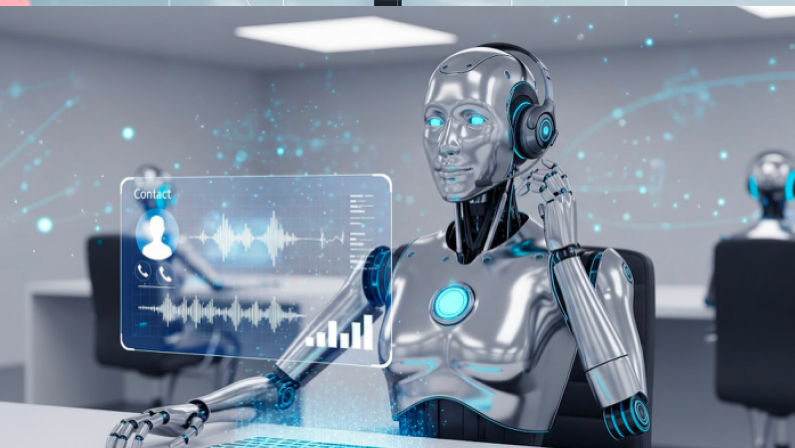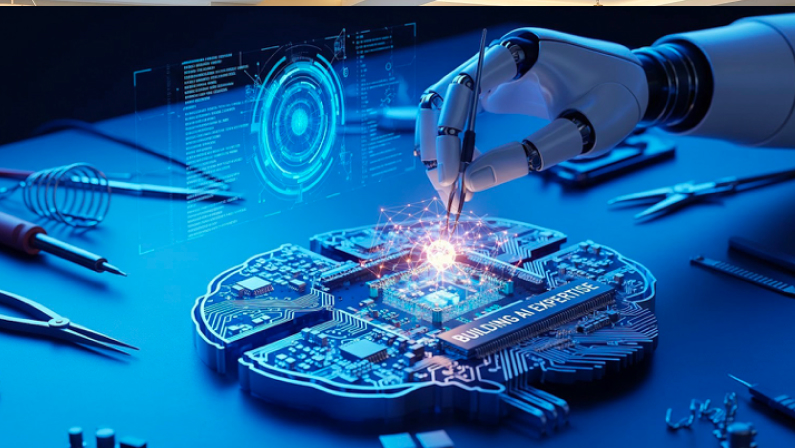
Automation has transformed the way businesses operate, streamlining processes, reducing errors, and improving efficiency. However, not all automation is the same. The debate between AI vs. traditional workflow automation has gained traction as companies seek smarter, more adaptive solutions.
Traditional workflow automation follows predefined rules and operates within fixed parameters, while AI-powered automation leverages machine learning in process automation to make intelligent decisions. Comparing robotic process automation vs. AI automation helps businesses understand the advantages of AI in adapting to complex workflows and dynamic decision-making.
What Is Workflow Automation?
Workflow automation is the process of using technology to execute business tasks and processes without manual intervention. It enhances efficiency, reduces human error, and improves consistency in business operations.
Traditional workflow automation typically relies on rule-based automation vs. AI-driven automation, where predefined steps dictate actions. On the other hand, AI-driven automation incorporates cognitive automation in business processes, enabling systems to learn, adapt, and make intelligent decisions.
How Does Traditional Workflow Automation Work?
Traditional workflow automation follows predefined rules and structured logic to execute repetitive tasks. It operates on a rule-based automation vs. AI-driven automation model, handling processes like invoice approvals, customer support chatbots, and data entry.
These systems improve efficiency but lack adaptability, requiring manual intervention when exceptions arise.
For example, an automated invoicing system routes approvals based on fixed conditions but cannot adjust to unexpected scenarios without human input.
What Is AI-Powered Workflow Automation?
AI-powered automation enhances traditional methods by using machine learning in process automation to analyze data, detect patterns, and make intelligent decisions. Unlike rigid rule-based systems, AI adapts to evolving scenarios through cognitive automation in business processes.
Examples include AI-driven chatbots that personalize responses and predictive maintenance systems that prevent equipment failures.
By continuously learning and optimizing workflows, AI automation reduces human oversight and improves intelligent workflow optimization in complex environments

How Do AI and Traditional Automation Differ in Functionality?
Traditional automation follows predefined rules and is best suited for repetitive tasks with fixed conditions. It requires manual updates for any changes and lacks flexibility in handling unexpected situations. In contrast, AI-powered automation adapts based on data patterns, making intelligent decisions without constant reprogramming.
AI can detect anomalies, optimize processes in real time, and improve over time by learning from new data.
While traditional automation is scalable for structured tasks, AI excels in dynamic environments, enhancing decision-making, accuracy, and efficiency. Businesses must assess their needs to determine which approach aligns best with their operations.
What Are the Key Benefits of AI Over Traditional Workflow Automation?
AI-powered automation offers significant advantages over traditional workflow automation, providing greater flexibility, intelligence, and efficiency in business operations.
Intelligent Workflow Optimization
AI can identify inefficiencies and optimize workflows in real time, reducing bottlenecks and improving overall productivity. By continuously analyzing data, it enables businesses to refine operations and enhance efficiency.
Enhanced Decision-Making
AI automation adapts based on changing data, improving business responsiveness to market fluctuations. It enables real-time adjustments, allowing companies to make smarter, data-driven decisions.
Improved Accuracy
AI minimizes human error by detecting inconsistencies and anomalies, ensuring greater precision in automated processes. This leads to higher reliability in critical business operations such as finance, healthcare, and logistics.
Increased Scalability
AI automation handles growing data volumes without needing extensive reprogramming, making it ideal for businesses experiencing rapid expansion. Its adaptability ensures smooth operations even as workload demands increase.
Better Customer Experience
AI-driven systems personalize interactions and anticipate customer needs, enhancing satisfaction and engagement. Through machine learning, businesses can deliver tailored solutions and proactive support to users.
What Are the Limitations of AI in Workflow Automation?
While AI-powered automation offers numerous benefits, it also comes with challenges such as high implementation costs, data dependency, and complex integration.
High Initial Costs
Implementing AI requires a significant investment in technology, training, and infrastructure. Businesses must allocate resources for AI development, maintenance, and ongoing improvements.
Data Dependency
AI relies on large datasets to function effectively, making data quality and availability crucial. Without sufficient, accurate data, AI models may produce unreliable or biased results.
Complex Implementation
Transitioning to AI requires seamless integration into existing workflows, which can be time-consuming and resource-intensive. Businesses must carefully plan deployment to avoid disruptions and inefficiencies.
Ethical and Security Concerns
AI decision-making can introduce biases if trained on skewed data, leading to unintended consequences. Strict data governance and ethical guidelines are essential to guarantee responsible AI usage.
Limited Human Oversight
AI can make autonomous decisions that may not always align with business objectives or ethical standards. Continuous monitoring and human intervention are necessary to make sure AI operates as intended.
When Should Businesses Choose Traditional Workflow Automation?
Traditional workflow automation is ideal for businesses that require structured, rule-based processes with minimal variability.
Fixed and Repetitive Tasks
Traditional automation is best for predictable, structured processes that follow clear, predefined rules. It maintains consistency and efficiency in tasks like data entry, invoice processing, and inventory management.
Cost-Sensitive Environments
Companies with limited budgets may prefer lower-cost traditional automation, which requires less investment in advanced technology. It provides an affordable solution for automating routine tasks without the complexity of AI integration.
Regulatory Compliance
Some industries require strict rule-based automation to meet legal standards and uphold accurate reporting. Traditional automation helps businesses maintain compliance by enforcing standardized processes and reducing human error.
Limited AI Expertise
Businesses without AI expertise may find traditional automation easier to implement since it doesn’t require complex machine-learning models. This approach allows companies to streamline operations without needing specialized technical skills.

When Should Businesses Opt for AI-Powered Automation?
Businesses should consider AI-powered automation when they need intelligent, adaptive solutions that go beyond predefined rules to enhance efficiency and decision-making.
Data-Driven Decision-Making
AI is ideal for businesses that rely on real-time data insights to make informed choices. It analyzes large datasets quickly, uncovering patterns that drive strategic decisions.
Complex Process Management
AI excels at handling unpredictable, multi-variable tasks that traditional automation cannot effectively manage. It continuously learns and adapts to optimize complex workflows.
Personalized Customer Experiences
AI automation enhances customer engagement through personalization, tailoring interactions based on user behavior. This leads to more relevant recommendations and improved satisfaction.
Scalability Needs
AI adapts to growing business demands with minimal reprogramming, making it highly scalable. It can efficiently manage increased workloads without requiring significant manual adjustments.

How Can Businesses Transition from Traditional to AI Automation?
Transitioning from traditional to AI-powered automation requires a strategic approach to ensure smooth integration and maximize efficiency gains.
Assess Current Workflows
Businesses should evaluate existing processes to identify inefficiencies and determine where automation can provide the most value. Understanding these gaps helps in selecting the right AI tools for optimization.
Set Clear Objectives
Defining specific automation goals secures alignment between AI implementation, business needs, and long-term strategies. Clear objectives help measure success and guide future improvements.
Invest in Data Infrastructure
A strong data foundation is essential for AI to function effectively, so businesses must improve their data collection, storage, and management systems. Quality data enables AI to make accurate predictions and optimize workflows.
Start with Pilot Projects
Testing AI in small, controlled environments allows businesses to assess its effectiveness before a full-scale rollout. Pilot projects help identify potential challenges and refine the implementation process.
Train Employees
Providing employees with the necessary training enables them to manage and collaborate with AI systems effectively. A well-trained workforce enhances adoption and maximizes the benefits of AI automation.
Which Workflow Automation Approach Is Right for Your Business?
Both traditional and AI-powered workflow automation have their place in modern business operations. Traditional automation is ideal for repetitive, structured tasks, while AI automation provides flexibility and intelligence for complex processes. Companies must evaluate their workflow needs, resources, and long-term goals to determine the best approach.
For businesses seeking predictive AI CRM solutions, Leapify CRM offers cutting-edge AI-driven automation to enhance efficiency and decision-making. Contact us today to explore how AI can revolutionize your workflow automation strategy!



